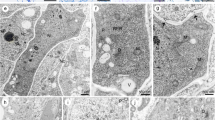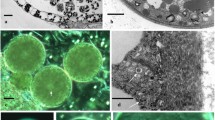Summary
In the aecium ofPuccinia sorghi the substantial outer layer of cell walls in the base of the stroma, together with the thick wall of peridial cells where they adjoin the compressed cell debris, may play a role in the water balance of the fruiting structure. With few exceptions binucleate cells are found only in the aecium. Cytoplasm of the binucleate peridial cells is densely filled with organelles and fat globules. Large multinucleate cells with inclusions, that are apparently proteinaceous in nature, are found in the aecial base. The ontogeny of aeciospore initials is annellidic and aeciosporophores have a well developed collar consisting of annellations. Sporophores, aeciospore initials, intercalary cells and young aeciospores are enveloped by a matrix. During aeciospore ontogeny fat globules are formed in the immediate vicinity of enlarging vacuoles and vesicle-containing structures, suggesting that the formation of fat globules is associated with these cytoplasmic components. Spine initials are first observed as electron-lucent areas between the plasmalemma and the wall of immature aeciospores. During further development the inter- and supraspinal wall of the spore is degraded, a process in which small, well-defined granules appear to be implicated. The spines become separated from the plasmalemma by wall apposition. Apposition also seals off the channel leading to the septal pore in the aeciospore base. The spore wall contains several germ pores. The vacuolate and often degenerate nature of inter- and intracellular hyphae in thalli with young sporulating aecia points to accumulation of food reserves in young aecia.
Similar content being viewed by others
References
Allen, Ruth F., 1934: A cytological study of heterothallism inPuccinia sorghi. J. Agric. Res.49, 1047–1068.
Craigie, J. H., 1927: Discovery of the function of the pycnia of the rust fungi. Nature120, 765–767.
Grand, L. F., andR. T. Moore, 1972: Scanning electron microscopy ofCronartium spores. Canad. J. Bot.50, 1741–1742.
Henderson, D. M., R. Eudall, andH. T. Prentice, 1972: Morphology of the reticulate teliospores ofPuccinia chaerophylli. Trans. Br. mycol. Soc.59, 229–232.
—,H. T. Prentice andR. Eudall, 1972: The morphology of fungal spores: III. The aecidiospores ofPuccinia poarum. Pollen et Spores14, 17–24.
Hiratsuka, Y., 1971: Spore surface morphology of pine stem rusts of Canada as observed under a scanning electron microscope. Canad. J. Bot.49, 371–372.
Hughes, S. J., 1953: Conidiophores, conidia, and classification. Canad. J. Bot.31, 577–659.
—, 1970: Ontogeny of spore forms inUredinales. Canad. J. Bot.48, 2147–2157.
Littlefield, L. J., andC. E. Bracker, 1971: Ultrastructure and development of urediospore ornamentation inMelampsora lini. Canad. J. Bot.49, 2067–2073.
Moore, R. T., 1963 a: Fine structure of mycota 10. Thallus formation inPuccinia podophylli aecia. Mycologia55, 633–642.
—, 1963 b: Fine structure of mycota XI. Occurrence of the Golgi dictyosome in the heterobasidiomycetePuccinia podophylli. J. Bacteriol.86, 866–871.
— andJ. H. McAlear, 1961: Fine structure of mycota 8. On the aecidial stage ofUromyces caladii. Phytopath. Z.42, 297–304.
Müller, Lorna Y., F. H. J.Rijkenberg, and Susarah J.Truter, 1974 a: Ultrastructure of the uredial stage ofUromyces appendiculatus. Submitted to Phytophylactica for publication.
- - - 1974 b: A preliminary ultrastructural study on theUromyces appendiculatus teliospore stage. Submitted to Phytophylactica for publication.
Rice, Mabel A., 1933: Reproduction in the rusts. Bull. Torrey Bot. Club60, 23–54.
Rijkenberg, F. H. J., andSusarah J. Truter, 1973: Haustoria and intracellular hyphae in the rusts. Phytopathology63, 281–286.
- - 1974: The ultrastructure of sporogenesis in the pycnial stage ofPuccinia sorghi. Mycologia: in press.
Savile, D. B. O., 1939: Nuclear structure and behavior in species of theUredinales. Amer. J. Bot.26, 585–609.
von Hofsten, Angelica, andL. Holm, 1968: Studies on the fine structure of aeciospores I. Grana Palynologica8, 235–251.
Walkinshaw, C. H., J. M. Hyde, andJanice van Zandt, 1967: Fine structure of quiescent and germinating aeciospores ofCronartium fusiforme. J. Bacteriol.94, 245–254.
Author information
Authors and Affiliations
Rights and permissions
About this article
Cite this article
Rijkenberg, F.H.J., Truter, S.J. The ultrastructure of thePuccinia sorghi aecial stage. Protoplasma 81, 231–245 (1974). https://doi.org/10.1007/BF01275814
Received:
Issue Date:
DOI: https://doi.org/10.1007/BF01275814




